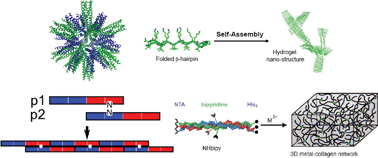In recent years our ability to design and assemble peptide-based materials and objects de novo (i.e. from first principles) has improved considerably. This brings us to a point where the resulting assemblies are quite sophisticated and amenable to engineering in new functions. Whilst such systems could be used in a variety of ways, biological applications are of particular interest because of the demand for biocompatible, readily produced systems with potential as drug-delivery agents, components of biosensors and scaffolds for 3D cell and tissue culture. This tutorial review describes the building blocks (or tectons) that are being used in peptide assembly, highlights a range of materials and objects that have been produced, notably hydrogels and virus-like particles, and introduces a number of potential applications for the designs.
You have access to this article
 Please wait while we load your content...
Something went wrong. Try again?
Please wait while we load your content...
Something went wrong. Try again?


 Please wait while we load your content...
Please wait while we load your content...